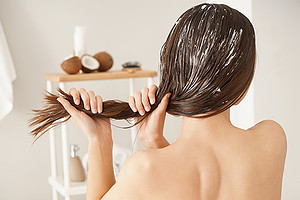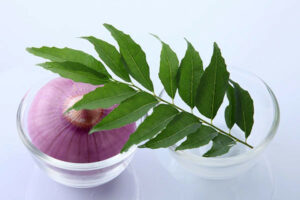The different shampoo types available today are:

- Everyday shampoo
- Clarifying shampoo
- Chelating shampoo
- Keratin shampoo
- Sulfate-free shampoo
- Oily hair shampoo
- Fine hair shampoo
- Medicated shampoo
- Organic shampoo
- Dry shampoo
- Volumizing shampoo
- Colored hair shampoo
The struggle to find the best shampoo for your hair is so real. It can be frustrating to try multiple products before finding the one that suits your hair’s needs.
One of the many reasons people take time before they find the shampoo that suits their hair is because there are so many variants on the market that boast multiple benefits.
But with a clear understanding of the different types of shampoos available for various hair types, you can get started on your journey to finding the one that suits you.
The 12 Different Shampoo Types
1. Everyday or daily shampoo
An everyday or daily shampoo is mild enough for you to use daily. People with an oily scalp or acne-prone scalp would typically use an everyday shampoo to keep the oil and sebum at bay.
Everyday shampoos contain mild detergents and do not contain conditioner. However, it is recommended to use a conditioner after shampooing in the shower; the conditioner should be rinsed completely from the hair before drying. (1)
You do not need to wash your hair daily if you have dry or rough hair, as it will strip away its natural oil even further. Simply avoid using just an everyday shampoo if you have wavy or curly hair, as you will have more frizz.
2. Clarifying shampoo
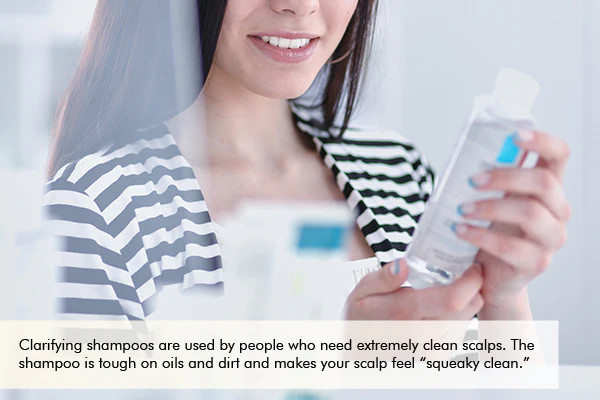
Deep-cleaning or clarifying shampoos are just the opposite of everyday shampoos. (2) Clarifying shampoos are used by people who need extremely clean scalps. The shampoo is tough on oils and dirt and makes your scalp feel “squeaky clean.”
It works best if you have straight hair. It is also generally beneficial if you have a scalp condition or you are getting a chemical treatment and need very cleansed hair.
Clarifying shampoos should be used once weekly to get rid of product buildup on the scalp. They, along with oily hair shampoos, contain lauryl sulfates as the main detergent. If you have dry, curly, or frizzy hair, avoid this type of shampoo as it removes oils from the hair and scalp.
3. Chelating shampoo: for intense cleaning
A chelating shampoo is much stronger than a clarifying shampoo, as it goes beyond the removal of oil and dirt. A chelating shampoo also washes away the metals, minerals, and chlorine from using hard water from your hair.
Chelating shampoos contain ingredients that break the bond between the mineral deposits and your hair. Some of the compounds present in this type of shampoo are EDTA, (3) sodium gluconate, and phytic acid. EDTA provides stability (4) in the shampoo and is used to break any mineral deposit due to the use of hard water.
This shampoo is preferred by those living in places where hard water is present and by swimmers who often use it. Both chelating and clarifying shampoos are harmful to the hair if used regularly.
4. Keratin shampoo: for damage repair
Keratin is present in the hair, skin, and nails, but due to harmful treatments, it can be destroyed. Keratin treatments are done to restore shine to the hair. (5)
Keratin shampoos help restore the amount of keratin found naturally in the hair. Keratin provides strength to your hair and protects the hair when using heat styling tools. (6)
The hair becomes brittle and damaged when keratin reduces, and using a keratin shampoo helps restore the balance and repair the damage. This type of shampoo contains keratin, biotin, D-panthenol, and other ingredients that reduce the frizz and damage on hair to make it robust and healthy.
5. Sulfate-free shampoo
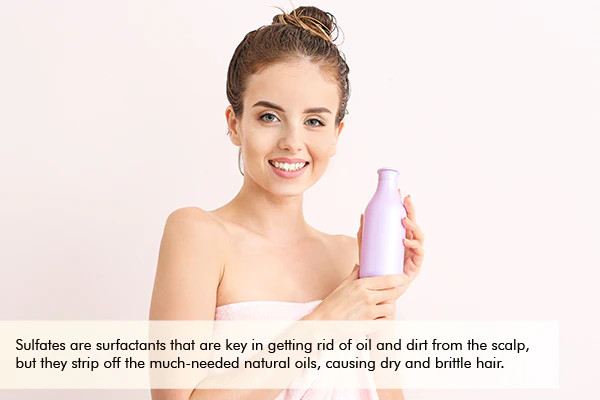
Sulfates are surfactants that are key in getting rid of oil and dirt from the scalp, but they strip off the much-needed natural oils, causing dry and brittle hair.
Sulfates also cause redness, dryness, and itching for people with sensitive scalps and those with dry, curly, and colored hair. For these reasons, various brands are offering sulfate-free shampoos.
A sulfate-free shampoo should be free from sodium laureth sulfate, sodium lauryl sulfate, and ammonium laureth sulfate, as these three are sulfate compounds usually found in shampoos. (7)
6. Oily hair shampoo
Oily hair can be a real struggle as you have to wash your hair every day to remove the excess oil on your hair and scalp.
An oily hair shampoo is the answer to your woes as it works by removing oil and sebum from the scalp. (2) Unlike a clarifying shampoo, it doesn’t strip off the natural oils in your hair. Oily hair shampoos with salicylic acid are perfect for you if you want to get rid of dead cells and combat dandruff.
Many oily hair shampoos have a high pH level, which can make your hair hydrated for a long time. While shampooing, leave it in your hair for about 2 minutes for it to work well, resulting in a clean and rejuvenated scalp and hair.
7. Fine hair shampoo

People with fine hair often have flat, greasy hair by the end of the day, so they shampoo their hair daily to eliminate the buildup.
If you have fine hair, do not use shampoos with conditioners, as they will weigh it down. Instead, use shampoos that contain cleansing agents suitable for fine hair.
8. Medicated shampoo
Medicated shampoos are perfect for scalps with fungal or bacterial infections. If you experience scalp itching and dandruff, it’s recommended that you use medicated shampoos.
Medicated shampoos contain pyrithione zinc, salicylic acid, or ketoconazole. They assist in managing scalp buildup, which is behind dandruff and an itchy scalp. (1)
9. Organic shampoo
People nowadays are shunning shampoos that contain harmful chemicals and prefer to use natural and plant-based shampoos containing organically sourced ingredients.
Organic shampoos are a much better and safe alternative to chemical-based shampoos as they contain essential oils and organic plant-based ingredients that are kinder to the hair and scalp. (8)
Opt for natural shampoos and conditioners that have onion in them as it is rich in sulfur and helps in hair regrowth and strengthening.
A plethora of herbal shampoos are available on the market that are not totally natural but contain herbal ingredients in a synthetic detergent base and chemical additives.
One study observed the hydrating effects of natural shampoos made in the lab in comparison with commercial herbal shampoos. Hair damage due to sodium lauryl sulfate was clearly seen in micrographs, and it was concluded that the lab formulations were better than the ones that were available commercially. (9)
10. Dry shampoo
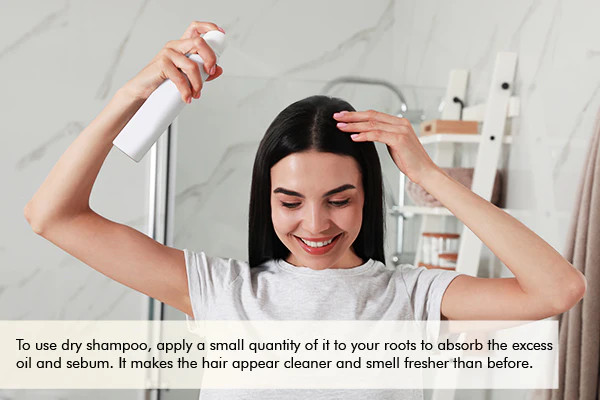
Dry shampoo is technically not a shampoo, but it works by absorbing hair oils and not cleaning the hair or scalp. It comes in a liquid, powder, or aerosol spray form and is excellent for people who want to cleanse their hair in between wash days.
To use dry shampoo, apply a small quantity of it to your roots to absorb the excess oil and sebum. It makes the hair appear cleaner and smell fresher than before, but you shouldn’t depend on dry shampoo alone as it can cause scalp buildup. (1)
11. Volumizing shampoo
Volumizing shampoos add much-needed volume to thin, dry hair that is prone to hair fall and breakage.
People use volumizing shampoos during winter to add life to flat and dull hair. A volumizing shampoo doesn’t weigh your hair down as it is made of lighter ingredients. (10)
To use a volumizing shampoo, massage it into your scalp for about 2 minutes to allow the product to work well, resulting in big bouncy hair after it has dried.
12. Colored hair shampoo
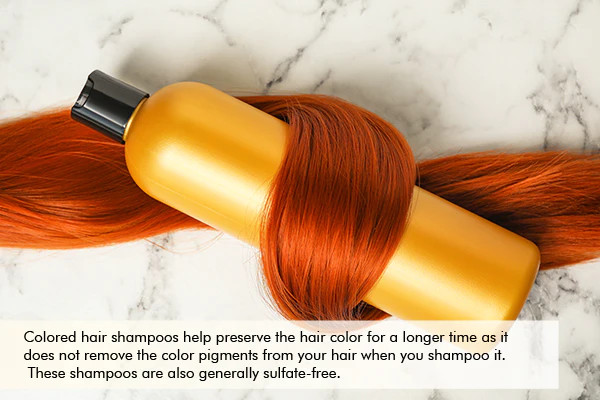
People with color-treated hair usually experience dry and coarse hair, color fading, and other problems after shampooing; the solution to these problems is using a shampoo specially formulated for colored hair.
Colored hair shampoos help preserve the hair color for a longer time as it does not remove the color pigments from your hair when you shampoo it. (11) These shampoos are also generally sulfate-free.
Final Word
Now that you have this guide on the 12 different types of shampoos, you can choose wisely depending on the type and condition of your hair and scalp. If you still cannot decide what shampoo would suit you, check with your hairstylist for expert advice.
References
- D’Souza P, Rathi SK. Shampoo and conditioners: What a dermatologist should know? Indian journal of dermatology. https://www.ncbi.nlm.nih.gov/pmc/articles/PMC4458934/. Published 2015.
- Draelos ZD. Essentials of hair care often neglected: Hair cleansing. International journal of trichology. https://www.ncbi.nlm.nih.gov/pmc/articles/PMC3002407/. Published January 2010.
- TA; LRSY. Final report on the safety assessment of EDTA, calcium disodium EDTA, diammonium EDTA, dipotassium EDTA, disodium EDTA, tea-EDTA, tetrasodium EDTA, tripotassium EDTA, trisodium EDTA, HEDTA, and Trisodium Hedta. International journal of toxicology. https://pubmed.ncbi.nlm.nih.gov/12396676/.
- Jung DS; Jung GH; Lee EH; Park HR; Kim JH; Kim KB; Kim HR; Kim HG; Effect of combined exposure to EDTA and zinc pyrithione on pyrithione absorption in rats. Toxicological research. https://pubmed.ncbi.nlm.nih.gov/31015897/.
- Hair keratin. Hair Keratin – an overview | ScienceDirect Topics. https://www.sciencedirect.com/topics/medicine-and-dentistry/hair-keratin.
- Cruz CF, Martins M, Egipto J, Osório H, Ribeiro A, Cavaco-Paulo A. Changing the shape of hair with keratin peptides. RSC Advances. https://pubs.rsc.org/en/content/articlelanding/2017/ra/c7ra10461h. Published November 6, 2017.
- Formulation and development of sulphate free shampoo – researchgate. https://www.researchgate.net/publication/340731431/.
- Sastrawidana1 DK, Pradnyana2 GA, Madiarsa3 M. IOPscience. Journal of Physics: Conference Series. https://iopscience.iop.org/article/10.1088/1742-6596/1317/1/012033/. Published October 1, 2019.
- CI; BJIRMARJ. A study on the conditioning effects of natural shampoos using the scanning electron microscope. International journal of cosmetic science. https://pubmed.ncbi.nlm.nih.gov/18498466/.
- Woyke E. The science behind your volumizing shampoo. MIT Technology Review. https://www.technologyreview.com/2016/11/02/107275/. Published April 2, 2020.
- Protection of oxidative hair color fading from shampoo … – researchgate. https://www.researchgate.net/publication/43297894/.





